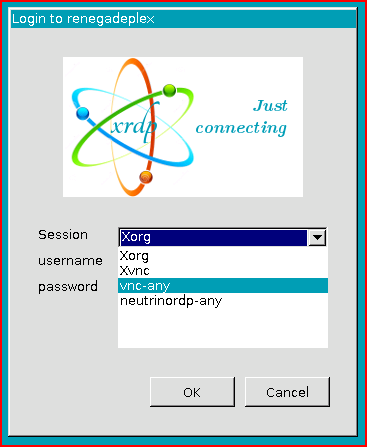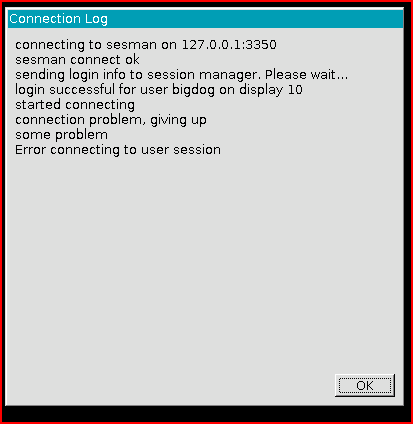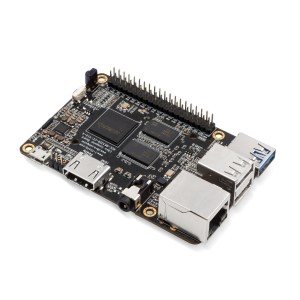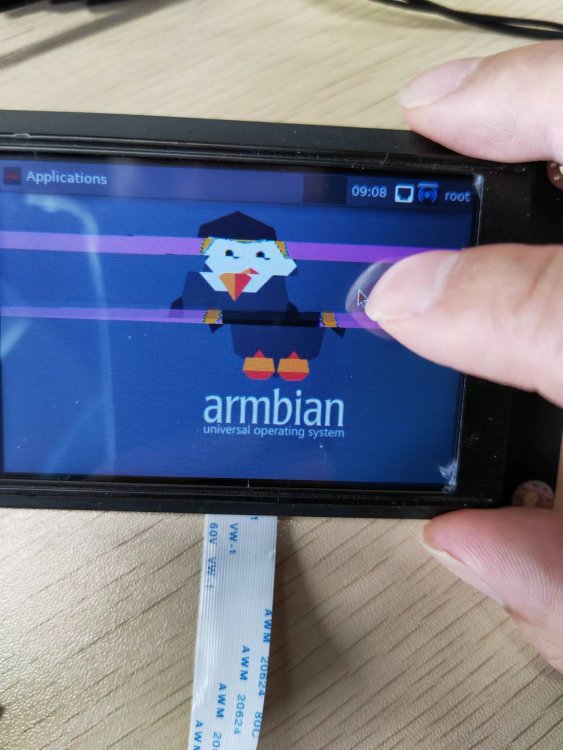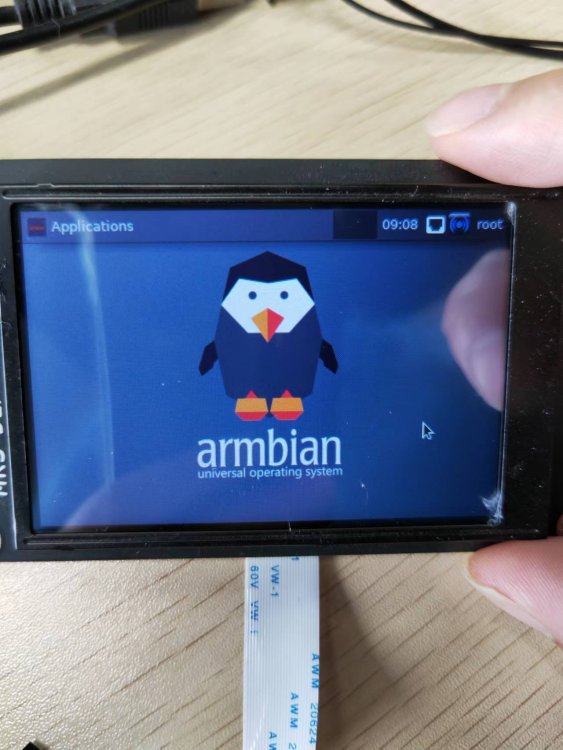Search the Community
Showing results for tags 'renegade'.
-
Sorry, don't have the Armbianmonitor info handy but wanted to get this started... I'm trying to bring up a Libre Renegade RK3328-CC for use as a media center. Armbian's performance is absolutely wonderful compared to the other builds I've tried on this box. Unfortunately, I want the HDMI output going to a Samsung Frame TV, and resolution negotiation fails badly -- I get obvious rasters with black between them, nowhere near the 4K that this TV model is capable of and not even a smooth conversion (Note that the eyes here suggests that the black line is occurring every third raster or something like that...) What information I have gathered so far: TV: Samsung 43" “The Frame”, model QN43LS03BAFXZA Firmware T-PTMAKVC-1622.4, BT-S 4K native resolution, but should be able to upconvert edid-decode (hex): 00 ff ff ff ff ff ff 00 4c 2d 7f 72 00 0e 00 01 01 20 01 03 80 5f 36 78 0a b3 61 ab 4f 46 a8 27 0b 50 54 bd ef 80 71 4f 81 c0 81 00 81 80 95 00 a9 c0 b3 00 d1 c0 04 74 00 30 f2 70 5a 80 b0 58 8a 00 50 1d 74 00 00 1e 56 5e 00 a0 a0 a0 29 50 30 20 35 00 50 1d 74 00 00 1a 00 00 00 fd 00 18 4b 0f 51 1e 00 0a 20 20 20 20 20 20 00 00 00 fc 00 53 41 4d 53 55 4e 47 0a 20 20 20 20 20 01 9f 02 03 51 f0 52 5f 10 1f 04 13 05 14 20 21 22 5d 5e 62 64 07 16 03 12 2f 0d 57 07 09 07 07 15 07 50 57 07 01 67 54 03 83 0f 00 00 e2 00 4f e3 05 c3 01 6e 03 0c 00 30 00 b8 44 20 00 80 01 02 03 04 e3 06 0d 01 e5 0e 60 61 65 66 e5 01 8b 84 90 01 02 3a 80 18 71 38 2d 40 58 2c 45 00 50 1d 74 00 00 1e 00 00 00 00 00 00 00 00 00 00 00 00 00 00 00 00 00 00 00 00 00 00 00 00 00 00 00 00 ea Block 0, Base EDID: EDID Structure Version & Revision: 1.3 Vendor & Product Identification: Manufacturer: SAM Model: 29311 Serial Number: 16780800 Made in: week 1 of 2022 Basic Display Parameters & Features: Digital display Maximum image size: 95 cm x 54 cm Gamma: 2.20 RGB color display First detailed timing is the preferred timing Color Characteristics: Red : 0.6699, 0.3115 Green: 0.2734, 0.6591 Blue : 0.1533, 0.0449 White: 0.3125, 0.3291 Established Timings I & II: IBM : 720x400 70.081663 Hz 9:5 31.467 kHz 28.320000 MHz DMT 0x04: 640x480 59.940476 Hz 4:3 31.469 kHz 25.175000 MHz Apple : 640x480 66.666667 Hz 4:3 35.000 kHz 30.240000 MHz DMT 0x05: 640x480 72.808802 Hz 4:3 37.861 kHz 31.500000 MHz DMT 0x06: 640x480 75.000000 Hz 4:3 37.500 kHz 31.500000 MHz DMT 0x09: 800x600 60.316541 Hz 4:3 37.879 kHz 40.000000 MHz DMT 0x0a: 800x600 72.187572 Hz 4:3 48.077 kHz 50.000000 MHz DMT 0x0b: 800x600 75.000000 Hz 4:3 46.875 kHz 49.500000 MHz Apple : 832x624 74.551266 Hz 4:3 49.726 kHz 57.284000 MHz DMT 0x10: 1024x768 60.003840 Hz 4:3 48.363 kHz 65.000000 MHz DMT 0x11: 1024x768 70.069359 Hz 4:3 56.476 kHz 75.000000 MHz DMT 0x12: 1024x768 75.028582 Hz 4:3 60.023 kHz 78.750000 MHz DMT 0x24: 1280x1024 75.024675 Hz 5:4 79.976 kHz 135.000000 MHz Apple : 1152x870 75.061550 Hz 192:145 68.681 kHz 100.000000 MHz Standard Timings: DMT 0x15: 1152x864 75.000000 Hz 4:3 67.500 kHz 108.000000 MHz DMT 0x55: 1280x720 60.000000 Hz 16:9 45.000 kHz 74.250000 MHz DMT 0x1c: 1280x800 59.810326 Hz 16:10 49.702 kHz 83.500000 MHz DMT 0x23: 1280x1024 60.019740 Hz 5:4 63.981 kHz 108.000000 MHz DMT 0x2f: 1440x900 59.887445 Hz 16:10 55.935 kHz 106.500000 MHz DMT 0x53: 1600x900 60.000000 Hz 16:9 60.000 kHz 108.000000 MHz (RB) DMT 0x3a: 1680x1050 59.954250 Hz 16:10 65.290 kHz 146.250000 MHz DMT 0x52: 1920x1080 60.000000 Hz 16:9 67.500 kHz 148.500000 MHz Detailed Timing Descriptors: DTD 1: 3840x2160 30.000000 Hz 16:9 67.500 kHz 297.000000 MHz (1872 mm x 1053 mm) Hfront 176 Hsync 88 Hback 296 Hpol P Vfront 8 Vsync 10 Vback 72 Vpol P DTD 2: 2560x1440 59.950550 Hz 16:9 88.787 kHz 241.500000 MHz (1872 mm x 1053 mm) Hfront 48 Hsync 32 Hback 80 Hpol P Vfront 3 Vsync 5 Vback 33 Vpol N Display Range Limits: Monitor ranges (GTF): 24-75 Hz V, 15-81 kHz H, max dotclock 300 MHz Display Product Name: ‘SAMSUNG’ Extension blocks: 1 Checksum: 0x9f Block 1, CTA-861 Extension Block: Revision: 3 Underscans IT Video Formats by default Basic audio support Supports YCbCr 4:4:4 Supports YCbCr 4:2:2 Native detailed modes: 0 Video Data Block: VIC 95: 3840x2160 30.000000 Hz 16:9 67.500 kHz 297.000000 MHz VIC 16: 1920x1080 60.000000 Hz 16:9 67.500 kHz 148.500000 MHz VIC 31: 1920x1080 50.000000 Hz 16:9 56.250 kHz 148.500000 MHz VIC 4: 1280x720 60.000000 Hz 16:9 45.000 kHz 74.250000 MHz VIC 19: 1280x720 50.000000 Hz 16:9 37.500 kHz 74.250000 MHz VIC 5: 1920x1080i 60.000000 Hz 16:9 33.750 kHz 74.250000 MHz VIC 20: 1920x1080i 50.000000 Hz 16:9 28.125 kHz 74.250000 MHz VIC 32: 1920x1080 24.000000 Hz 16:9 27.000 kHz 74.250000 MHz VIC 33: 1920x1080 25.000000 Hz 16:9 28.125 kHz 74.250000 MHz VIC 34: 1920x1080 30.000000 Hz 16:9 33.750 kHz 74.250000 MHz VIC 93: 3840x2160 24.000000 Hz 16:9 54.000 kHz 297.000000 MHz VIC 94: 3840x2160 25.000000 Hz 16:9 56.250 kHz 297.000000 MHz VIC 98: 4096x2160 24.000000 Hz 256:135 54.000 kHz 297.000000 MHz VIC 100: 4096x2160 30.000000 Hz 256:135 67.500 kHz 297.000000 MHz VIC 7: 1440x480i 59.940060 Hz 16:9 15.734 kHz 27.000000 MHz VIC 22: 1440x576i 50.000000 Hz 16:9 15.625 kHz 27.000000 MHz VIC 3: 720x480 59.940060 Hz 16:9 31.469 kHz 27.000000 MHz VIC 18: 720x576 50.000000 Hz 16:9 31.250 kHz 27.000000 MHz Audio Data Block: Linear PCM: Max channels: 6 Supported sample rates (kHz): 192 96 48 44.1 32 Supported sample sizes (bits): 24 20 16 Linear PCM: Max channels: 2 Supported sample rates (kHz): 48 44.1 32 Supported sample sizes (bits): 24 20 16 AC-3: Max channels: 6 Supported sample rates (kHz): 48 44.1 32 Maximum bit rate: 640 kb/s Enhanced AC-3 (DD+): Max channels: 8 Supported sample rates (kHz): 48 44.1 32 Supports Joint Object Coding MAT (MLP): Max channels: 8 Supported sample rates (kHz): 192 96 48 Supports Dolby TrueHD, object audio PCM and channel-based PCM Hash calculation not required for object audio PCM or channel-based PCM Speaker Allocation Data Block: FL/FR - Front Left/Right LFE1 - Low Frequency Effects 1 FC - Front Center BL/BR - Back Left/Right Video Capability Data Block: YCbCr quantization: No Data RGB quantization: Selectable (via AVI Q) PT scan behavior: No Data IT scan behavior: Supports both over- and underscan CE scan behavior: Supports both over- and underscan Colorimetry Data Block: xvYCC601 xvYCC709 BT2020YCC BT2020RGB Reserved MD0 Vendor-Specific Data Block (HDMI), OUI 00-0C-03: Source physical address: 3.0.0.0 Supports_AI DC_36bit DC_30bit DC_Y444 Maximum TMDS clock: 340 MHz Extended HDMI video details: HDMI VICs: HDMI VIC 1: 3840x2160 30.000000 Hz 16:9 67.500 kHz 297.000000 MHz HDMI VIC 2: 3840x2160 25.000000 Hz 16:9 56.250 kHz 297.000000 MHz HDMI VIC 3: 3840x2160 24.000000 Hz 16:9 54.000 kHz 297.000000 MHz HDMI VIC 4: 4096x2160 24.000000 Hz 256:135 54.000 kHz 297.000000 MHz HDR Static Metadata Data Block: Electro optical transfer functions: Traditional gamma - SDR luminance range SMPTE ST2084 Hybrid Log-Gamma Supported static metadata descriptors: Static metadata type 1 YCbCr 4:2:0 Video Data Block: VIC 96: 3840x2160 50.000000 Hz 16:9 112.500 kHz 594.000000 MHz VIC 97: 3840x2160 60.000000 Hz 16:9 135.000 kHz 594.000000 MHz VIC 101: 4096x2160 50.000000 Hz 256:135 112.500 kHz 594.000000 MHz VIC 102: 4096x2160 60.000000 Hz 256:135 135.000 kHz 594.000000 MHz Vendor-Specific Video Data Block (HDR10+), OUI 90-84-8B: Application Version: 1 Detailed Timing Descriptors: DTD 3: 1920x1080 60.000000 Hz 16:9 67.500 kHz 148.500000 MHz (1872 mm x 1053 mm) Hfront 88 Hsync 44 Hback 148 Hpol P Vfront 4 Vsync 5 Vback 36 Vpol P Checksum: 0xea I understand that Armbian is an experimental build and this combination may simply not work.... but if there's anything I can try to do to help the driver and monitor reconcile with each other, or to help you debug this, please let me know. (BTW, I don't mind the security timeout/rechecking on this webform, but having it drag focus back to that checkbox is somewhat disruptive.)
-
The Libre Computer Renegade RK3328 has hardware AES support. Should it not be listed by `lsmod` if the module is activated? $ grep aes /proc/cpuinfo Features : fp asimd evtstrm aes pmull sha1 sha2 crc32 cpuid Features : fp asimd evtstrm aes pmull sha1 sha2 crc32 cpuid Features : fp asimd evtstrm aes pmull sha1 sha2 crc32 cpuid Features : fp asimd evtstrm aes pmull sha1 sha2 crc32 cpuid $ lsmod | grep aes $ How can one verify that the AES chip is being utilized? I'm on the Armbian 22.11 Jammy release (Kernel 5.15.y, Release date: Nov 30, 2022).
-
Looking for information on enabling 4 wire SPI on the Libre Renegade. I think have it enabled (spi-spidev) in armbian-config and I think configured correctly in /boot/armbianEnv.txt: param_spidev_spi_bus=0 param_spidev_spi_cs=0 param_spidev_max_freq=1000000 Connecting to pins GPIO pin# 19/21/23/24 I still do not see ANY devices matching /dev/spi* - An guidance as to WHY? I have the build framework, but am new to building armbian kernels but could navigate it with some direction. TIA folks! [Trying to connect a 240x320 LCD display using the ST7789-VW controller, not using Arduino IDE]
-
I am running Armbian 23.05.01 bookworm, release 12, on a Libre Renegade (ROC-RK3329-CC) I installed RDP from Armbian config. Seems to have installed. I've shutdown, restarted several times. First I get a black screen on my Windows PC Then the screen turns turq and I see this error: When I click the OK I see this dialog: I've tried every one of those options and none work. I've tried them from my created user and also with root - no joy. I get an error like this: I posted here, not knowing exactly where to start. Dan Reynolds
-
I'm running Armbian Jammy (23.02.2) aarch64, Xfce 4.16, Kernel: 5.15.93-rockchip64 on a Libre Renegade and would like to change the resolution to 1360x768. I have tried the Display Settings which only has 1280x720 and I can't change the scale, also I have tried changing the values in Settings Editor but that doesn't change anything. (DISPLAY=:0 xrandr -q) shows: xrandr: Failed to get size of gamma for output default Screen 0: minimum 1280 x 720, current 1280 x 720, maximum 1280 x 720 default connected 1280x720+0+0 0mm x 0mm 1280x720 0.00* I have limited experience with XFCE and terminal commands, any help is appreciated thanks.
-
I have built my armbian system on a Renegade board, and I need to back up the entire system so that I can copy it to other sdcards. I tried to use Win32DiskImager.exe to read out the system, but the size of the image read out is much larger than the space occupied by the system, which is basically equal to the size of the card. Any good suggestions?
-
Hey guys, brand new to linux so sorry for obvious/easy question being obvious/easy I wanted to set up Pi Hole on my new Renegade, but I cannot figure out how to make/find a static ip address. I have found the IPv4 settings, tried to create an ip address in there, but I don't think it worked. Thanks for any help or advice you can give me, after I get the static IP address set hopefully I won't have any more problems setting up Pi Hole. Thanks again!
-
Ok so I think I have this figured out. It doesn't work at all in Armbian 23.05.1 with the 6.x kernel no matter what I try. It does work in the older Armbian 23.02.2 Jammy (kernel 5.15.93) but the given instructions didn't work for me and needed additional commands. I had to enable the rk3328-opp-1.5ghz overlay or else the max frequency was locked to 1296 MHz. I also found the MAX_SPEED value in the instructions to be too low. To get it to work in 23.02.2: First you have to enable the rk3328-opp-1.5ghz overlay in armbian-config (System > Hardware > rk3328-opp-1.5ghz) or just add it to the overlays line in /boot/armbianEnv.txt and reboot. Next open the /etc/default/cpufrequtils file and find the MAX_SPEED line. Change the MAX_SPEED to 1512000 and save. Now restart the cpufrequtil service and armbianmonitor -m should show 1512 MHz. If the frequency is still locked then check /sys/devices/system/cpu/cpufreq/policy0/cpuinfo_max_freq. If it outputs the lower value then the overlay didn't apply. Original post: Hello, I recently purchased a Libre Renegade (RK3328) and installed the latest Armbian release (Armbian 23.05.1 jammy) from this page. On that same page it lists instructions to adjust the maximum clock speed to 1.5 GHz but they appear to not have any effect as armbianmonitor -m never shows the new maximum clock (I can lower it though, I just can't go above 1296 MHz). I've attempted to enable the rk3328-opp-1.5ghz overlay using armbian-config but it doesn't appear to be working. Here's my armbianmonitor output: https://paste.armbian.com/iyagokujij (temps are high because I had the fan off, I do have a heatsink and fan) Thanks in advance for any help you can provide.
-
Hey, I’ve read you can save 40Ma, can anyone tell me what is the best way of disabling HDMI? TIA
-
Hi, trying to nut out the problem of being unable to restart after installation of the OMV Wireguard plugin. I have removed the wireguard-tools package and installed the 4 rockchip64 edge 6.1.11 packages. It took me a while to realise that armbian-config was not installing the headers when selected but wondering if there's a necessary order for installation ie linux-source-6.1.11-edge-rockchip64 first maybe? Sorry I realise how tedious it is supporting folks who are feeling around in the dark but I've wasted so many hours starting from scratch I either have to give up or ask for a tip. TIA
-
I cant use the number keys on my keyboard to type in 1234 as the manual says. I can only type in "root" at the login but I cant type anything in the password section.
-

The latest edge version fail to boot with Renegade board(RK3328)
DavidJS posted a question in Other families
I cloned the quite latest version of Armbian: commit 369e69a55390f59c2299c98c09bf3d805ac59335 (HEAD -> main, origin/main, origin/HEAD) Author: Ricardo Pardini <ricardo@pardini.net> Date: Mon Apr 3 13:15:54 2023 +0200 artifact-armbian-bsp-cli: hash more variables included in `/etc/armbian-release` Using the edge branch to compile for my renegade board, which has the rk3328 chip: ./compile.sh BOARD=renegade BRANCH=edge RELEASE=bullseye BUILD_MINIMAL=no BUILD_DESKTOP=no KERNEL_CONFIGURE=no COMPRESS_OUTPUTIMAGE=sha,img It blocks when start to boot the kernel: U-Boot 2022.07-armbian (Apr 17 2023 - 23:29:15 +0800) Model: Firefly roc-rk3328-cc DRAM: 1022 MiB PMIC: RK8050 (on=0x50, off=0x01) Core: 227 devices, 23 uclasses, devicetree: separate MMC: mmc@ff500000: 1, mmc@ff520000: 0 Loading Environment from MMC... Card did not respond to voltage select! : -110 *** Warning - No block device, using default environment In: serial@ff130000 Out: serial@ff130000 Err: serial@ff130000 Model: Firefly roc-rk3328-cc Net: eth0: ethernet@ff540000 Hit any key to stop autoboot: 0 Card did not respond to voltage select! : -110 switch to partitions #0, OK mmc0(part 0) is current device Scanning mmc 0:1... Found U-Boot script /boot/boot.scr 3252 bytes read in 3 ms (1 MiB/s) ## Executing script at 00500000 Boot script loaded from mmc 0 117 bytes read in 2 ms (56.6 KiB/s) 20639437 bytes read in 468 ms (42.1 MiB/s) 29397504 bytes read in 666 ms (42.1 MiB/s) 63592 bytes read in 7 ms (8.7 MiB/s) 2698 bytes read in 6 ms (438.5 KiB/s) Applying kernel provided DT fixup script (rockchip-fixup.scr) ## Executing script at 09000000 Unknown command 'kaslrseed' - try 'help' Moving Image from 0x2080000 to 0x2200000, end=3ea0000 ## Loading init Ramdisk from Legacy Image at 06000000 ... Image Name: uInitrd Image Type: AArch64 Linux RAMDisk Image (gzip compressed) Data Size: 20639373 Bytes = 19.7 MiB Load Address: 00000000 Entry Point: 00000000 Verifying Checksum ... OK ## Flattened Device Tree blob at 01f00000 Booting using the fdt blob at 0x1f00000 Loading Ramdisk to 3cb6f000, end 3df1de8d ... OK Loading Device Tree to 000000003caf7000, end 000000003cb6efff ... OK Starting kernel ... efi_free_pool: illegal free 0x000000003cf20040 efi_free_pool: illegal free 0x000000003cf1d040 I don't know what happen, the boad is ok using the old version. -
Here in the forum the psu mod for the roc-rk3328-cc board was discussed. Does anyone know where I can find instructions on how to do this exactly?
-
I've burned the latest Focal image onto Renegade board. Everything works fine except rebooting it via command. Once the reboot is entered, the console log showed it tried to reboot but stuck with the following info. The above Armbianmonitor is a zip file, please download it and save as zip file then unzip to get the detail log. I guess it was due to issue in dtb file but has no clue. Is there any genius can help on this? [ 97.418882] watchdog: watchdog0: watchdog did not stop! [ 97.672510] reboot: Restarting system INFO: PSCI Power Domain Map: INFO: Domain Nod State ON (0x0) INFO: Doma parent_node 0, State ON (0x0) e : Level 0, parent_node 0, StatFO: Domain Node : Level 0, ON (0x0) INFO: CPU Node : _node 1, State ON (0x0) INFO: 0x1, parent_node 1, State ON (0xNFO: CPU Node : MPID 0x2, pState ON (0x0) INFO: CPU N0x3, parent_node 1, State ON (0x␀
-
I've tried to reinstall multiple times. Armbian runs fine and i am able to SSH and do everything on it, but hdmi display plugged in gets no signal. I installed Armbian 22.11 Jammy XFCE and non. Both give me no output. I'm using a big enough power supply, and nothing. I am attaching the output i got on the armbianmonitor U http://paste.debian.net/1270237/
-
Having a problem with my board and screen. Recently purchased a couple of inexpensive touch screens that work dandy for pi and lepotato but the resolution on renegade is too high and text just looks like dust on a 7 inch monitor. I took a look at potato xorg driver.conf and there's a lot of modes listed, but on renegade I see: Section "Device" Identifier "NOGPU" Driver "fdev" Endsection And xrandr -- listmonitors output: Failed to get size of gamma for output default Monitors 1 0: +default 1600/423x900/238+0+0. I'm still learning things, but I know exactly how to brick it again 😃. I hope I have enough information for you and your assistance will be greatly appreciated.
-
At first, the card was recognized as a Mass Storage, I used usb_modeswitch to make it recognized as a wifi card, but iwconfig still didn't show this card, and /sys/kernel/debug/ieee80211 did exist, but was empty. I don't think it's a driver issue because when I plugged this card into my debian laptop, it worked even without usb_modeswitch. journalctl and lsusb logs are in the files. journalctl.log lsusb.log
-
WIP https://libre.computer/products/boards/roc-rk3328-cc/ Pro: - yet another RK3328 Cons: - micro USB powering
-
Am i not looking in the right place ? I am trying to get the image for this board. But I cant seem to find a download link. I proceed to look at other boards and I dont see download links anywhere. Some insight on this normally trivial task would be appreciated. https://www.armbian.com/renegade/
-
I have two renegade SBCs, both of them flash armbian_22.02, one bullseye,another focal with xfce. Bullseye on hardware viersion v1.0, Focal on v1.3. They both can't discovery USB3.0 devices through USB3.0 which plug before boot. I installed openmediavault, setting up share folders on USB3.0 mobile disk, test it can work properly, then reboot. After reboot, Disk can't be discoveryed, light on disk bright but not flash. I keep waiting 30 minutes, no external disk be found. And, they can discovery devices on USB3.0 which plug after booted. But sometimes can't, only USB2.0 devices plug in USB3.0 port can be found. Example, I plug an USB3.0 disk after booted, system auto mount it. But when I unplugged and plug twice ,nothing mounted or shown in fdisk. USB3 to ethernet(MS Model 1663) also, sometimes it can work on USB3.0, and sometimes it cannot work, I need to slow down to plug, to make it work on USB2.0 mode.
-
Good morning, I've got a Libre Computer Renegade, with Amrbian Bullseye minimal (on an sd card) . Changing HDMI monitors (of different sizes and resolutions) the board does not adjust automatically the resolution, so, sometimes the display is unreadable because written are too small, and I can't set a resolution to beng able to use it. Surfing armbian docs, it seems to be an environment problems that could be solved by chanching u-boot parameters. I tried to enter in u-boot command shell but I can't. Pushing backspace while it is booting make no effect (tried also with serial console but it didn't work). How can I enter in u-boot environment to set an HDMI monitor resolution? Thanks in advance
-
Good Morning, I'm using Libre renegade with armbian bullseye minimal. How can I change splash screen, replacing the armbian logo and 4 penguins, with a personal one? Has anybody done it eralier? Thanks in advance
-
Hello, I am using my Renegade with the Armbian I compiled myself. Now there is only one partition on my system: Number Start End Size Type File system Flags 0.03MiB 16.0MiB 16.0MiB Free Space 1 16.0MiB 5580MiB 5564MiB primary ext4 5580MiB 7620MiB 2040MiB Free Space I want to add a boot partition like Raspberry OS, so I can make some configration on the PC through boot partition. Raspberry OS's partition always like that: Number Start End Size Type File system Flags 0.02MiB 4.00MiB 3.98MiB Free Space 1 4.00MiB 260MiB 256MiB primary fat32 lba 2 260MiB 14939MiB 14679MiB primary ext4 14939MiB 14940MiB 0.95MiB Free Space Is there any method?
-
I use the spi0 of Renegade to drive a 3.5-inch touchscreen, both the lcd and touchscreen use the same spi0, but different "CS". If I don't touch, the display is ok. But when touch the screen, the display gets messed up, looking like the colors are misaligned starting from an offset value. Anybody has experience of it ? Thank you! (The first and second images get messed up as I touch on screen, the third image is ok as I don't touch.)
-
I compiled the Armbian on renegade board, based on mainline linux, compiling was stopped as the output: LD vmlinux.o MODPOST vmlinux.symvers MODINFO modules.builtin.modinfo GEN modules.builtin LD .tmp_vmlinux.kallsyms1 [ error ] ERROR in function compile_kernel [ main.sh:589 -> main.sh:490 -> compilation.sh:506 -> general.sh:0 ] [ error ] Kernel was not built [ @host ] [ o.k. ] Process terminated And the logs files are in the attachments. Today the linux kernel auto updates to 5.15.36, I haven't this issue using 5.15.35 before. Anybody know why? logs.zip



